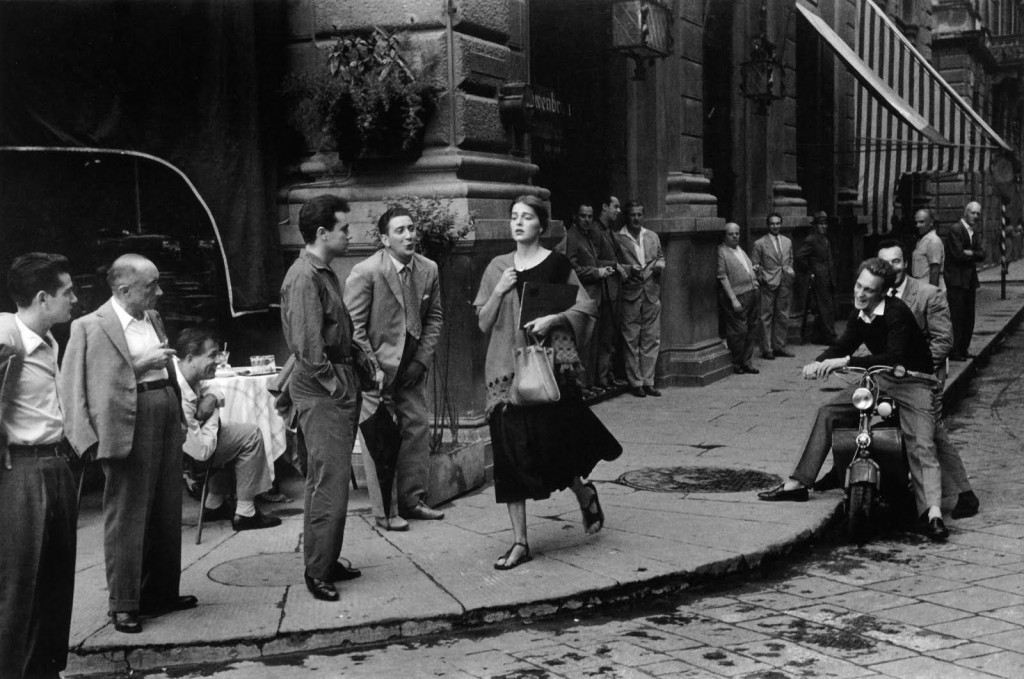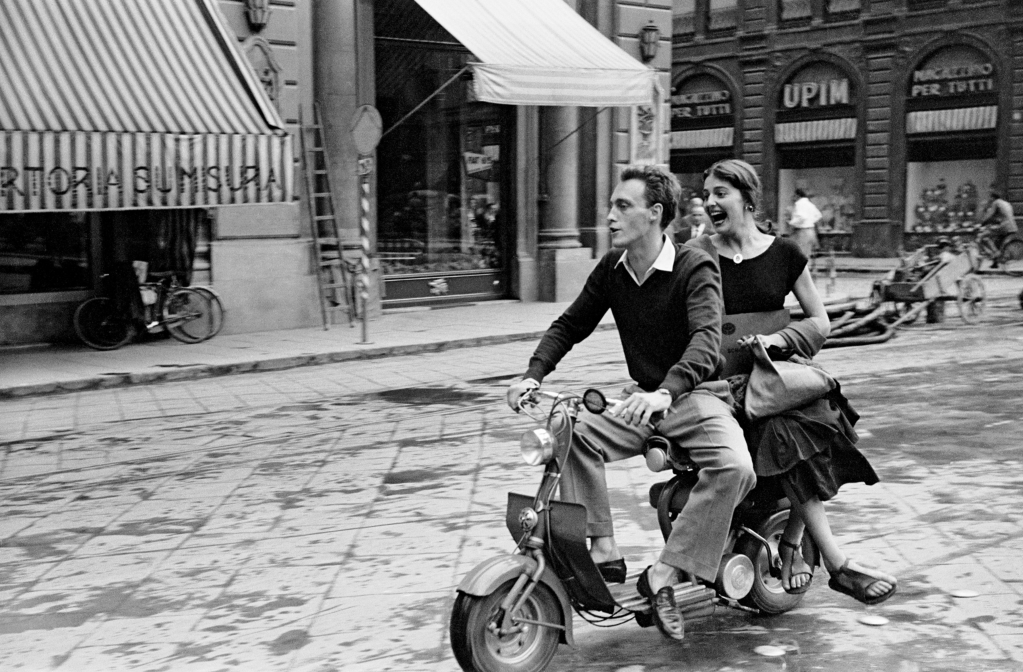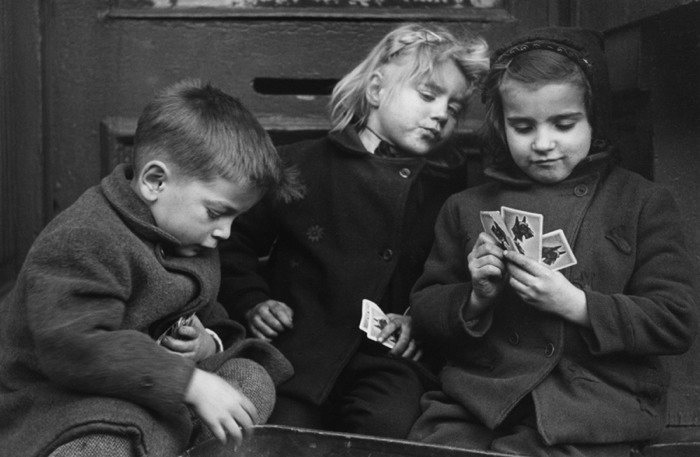
Conoces la foto. La has visto cientos de veces. Una hermosa, escultural y joven mujer está caminando por una calle de Florencia, Italia. Sostiene su chal, y parece moverse con rapidez. Más de una docena de hombres la miran con deseo. Uno de ellos agarra su entrepierna.
La icónica imagen de 1951 “American Girl in Italy” ha cumplido 60 años. Cuando se acerca su aniversario, la impresionante mujer de la foto – Ninalee Craig, de 83 años – habla acerca de ello. Quiere explicar lo que la foto representa y lo que no lo hace.
“Hay gente que quiere utilizarla como un símbolo de acoso a las mujeres, pero eso es por lo que hemos estado luchando todos estos años”, dijo Craig en una entrevista telefónica desde su casa en Toronto. “No es un símbolo de acoso. Es un símbolo de una mujer pasándolo maravillosamente bien!”
En 1951, Craig era una despreocupada de 23 años que había dejado su trabajo en Nueva York y se aseguró alojamiento de tercera clase en un barco con destino a Europa. Pasó más de seis meses viajando por Francia, España e Italia, sola – algo que muy pocas mujeres hicieron en los años posteriores a la Segunda Guerra Mundial.
Viajó como pudo a bajo costo, así que se emocionó cuando descubrió un hotel a orillas del río Arno en Florencia, donde se podía quedar por 1 dólar al día. Allí conoció a otra aventurera viajera solitaria: Ruth Orkin, una fotógrafa de 29 años de edad, que llegó a Italia después de completar una misión en Israel.
“Ella vivía el día a día, con lo justo”, recordó Craig. “Hablamos acerca de viajar solas y nos preguntábamos la una a la otra:” ¿Lo estás pasando mal? ¿Te has sentido molesta alguna vez? “Las dos nos dimos cuenta de que estábamos pasando un tiempo maravilloso, y sólo algunas cosas eran un poco difícil”.
En el curso de esa conversación, se fraguó una idea: Al día siguiente se dirigirían juntas a pasear por Florencia y tomar fotos de lo que era realmente viajar sola como una joven mujer soltera.
Desde las 10 a.m. hasta el mediodía del día siguiente, Orkin disparó fotos de Craig – que luego se llamó a sí misma “Jinx Allen”, un nombre que inventó y adoptó porque sonaba “emocionante” – admirando estatuas, preguntando por direcciones, regateando en los mercados y coqueteando en los cafés.
“Estábamos literalmente haciendo el tonto”, dijo Craig, recordando el brillante chal naranja que llevaba ese día.
Orkin capturó su famosa fotografía “American Girl in Italy” durante las dos horas de estupidez y diversión. Sus hojas de contacto de ese día revelan que ella tiró sólo dos tomas de esa escena de calle en concreto.
“El gran debate acerca de la imagen, que todo el mundo siempre quiere saber es: ¿Estaba organizado? NO! “, dijo Craig. “No, no, no! Usted no tiene 15 personas para una imagen y hace sólo dos tomas. Los hombres estaban allí… Lo único que ocurrió fue que Ruth Orkin fue lo suficientemente sabia como para pedirme que diera la vuelta, y volver atrás y repetir [el paseo]. ”
Orkin murió en 1985. Su hija, Mary Engel, ha dedicado su vida a proteger archivo fotográfico de su madre y la promoción de su legado como fotógrafa documental. Engel estuvo de acuerdo con lo que Craig cuenta de lo que sucedió ese día de agosto en Florencia, y añadió un detalle más contextual.
“Ella le dijo al hombre de la motocicleta que dijera a los otros hombres que no miraran a la cámara”, dijo Engel, directora del archivo fotográfico Orkin/Engel Film. “Pero la composición, simplemente ocurrió. Y mi madre lo capturó. Eso es en lo que ella era buena… Ella no tomó montones y montones de fotos. Esperó para disparar.”
Por supuesto, una buena fotografía documental da la bienvenida a los espectadores en una escena y les invita a sus interpretaciones. Eso es comprensible, dicen Craig y Engel – pero ambas subrayan la misma idea sobre “American Girl in Italy”: La foto es ante todo una celebración de las mujeres fuertes e independientes que no tienen miedo de vivir la vida.
//
You know the photo. You’ve seen it a hundred times. A beautiful, statuesque young woman is walking down a street in Florence, Italy. She’s clutching her shawl, and she seems to be moving swiftly. More than a dozen men are staring at her longingly. One of them is grabbing his crotch.
The iconic 1951 image “American Girl in Italy” has turned 60. As its anniversary approaches, the stunning woman in the photo — Ninalee Craig, now 83 — is speaking up about it. She wants to explain what the photo represents, and what it doesn’t.
“Some people want to use it as a symbol of harassment of women, but that’s what we’ve been fighting all these years,” Craig said in a telephone interview from her home in Toronto. “It’s not a symbol of harassment. It’s a symbol of a woman having an absolutely wonderful time!”
Back in 1951, Craig was a carefree 23-year-old who had chucked her job in New York and secured third-class accommodations on a ship bound for Europe. She spent more than six months making her way through France, Spain and Italy all by herself — something very few women did in the years following World War II.
She traveled as inexpensively as she could, so she was thrilled when she found a hotel right on the Arno River in Florence where she could stay for $1 a day. There, she met another adventurous solo female traveler: Ruth Orkin, a 29-year-old photographer who came to Italy after completing an assignment in Israel.
“She was living from day to day, nickel-and-diming it,” Craig recalled. “We talked about traveling alone and asked each other, ‘Are you having a hard time? Are you ever bothered?’ We both found that we were having a wonderful time, and only some things were a little difficult.”
In the course of that conversation, an idea was hatched: They would head out together the next morning, wander around Florence and shoot pictures of what it was really like to travel alone as a young single woman.
From about 10 a.m. to noon the following day, Orkin shot photos of Craig — who then called herself “Jinx Allen,” a name she invented and assumed because it sounded “exciting” — admiring statues, asking for directions, haggling at markets and flirting in cafes.
“We were literally horsing around,” Craig said, reminiscing about the bright orange shawl she wore that day.
Orkin captured her famous “American Girl in Italy” photograph during those two hours of silliness and fun. Her contact sheets from that day reveal that she shot only two frames of that particular street scene.
“The big debate about the picture, which everyone always wants to know, is: Was it staged? NO!” Craig said. “No, no, no! You don’t have 15 men in a picture and take just two shots. The men were just there … The only thing that happened was that Ruth Orkin was wise enough to ask me to turn around and go back and repeat [the walk].”
Orkin died in 1985. Her daughter, Mary Engel, has devoted her life to protecting her mother’s photographic archive and promoting her legacy as a documentary photographer. Engel agreed with Craig’s account of what happened on that August day in Florence, and she added one more contextual detail.
“She told the man on motorcycle to tell the other men not to look at the camera,” said Engel, director of the Orkin/Engel Film and Photo Archive. “But the composition, it just happened. And my mother got it. That’s what she was good at. … She didn’t take loads and loads of photos. She waited for shots.”
Of course, a good documentary photograph welcomes viewers into a scene and invites their interpretations. That’s understandable, say Craig and Engel — but both of them stress the same point about “American Girl in Italy”: The photo is primarily a celebration of strong, independent women who aren’t afraid to live life.
(via: http://www.today.com/)


Compartir esto // Share this:











